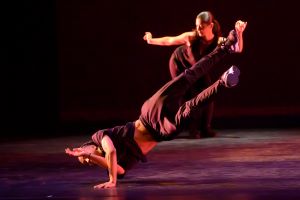A sudden, grievous red light cast the Greensboro Opera stage as cellist Cremaine Booker and percussionist David Verin churned up the sounds of undeniable frustration. Lead soprano and librettist, Roberta Gumbel, stumbled on stage, tired, and lamenting over the reality of her world. So close to the backdrop of light, Gumbel appeared like a silhouette, giving her anonymous multiplicity and extending grief beyond her characterization. And then the lighting changed to blue. Booker set the scene at a Miami beach swimming pool, while Gumbel was suddenly collected, leisurely, and Caucasian as she misidentifies a black man as a pool employee. Change again, the scene is pink. Now a mother sitting in the passenger seat of a car, Gumbel worries about her child sitting in the car seat behind her. Did her husband install it correctly? She needs to be able to see her son. Moving into the backseat, she sings to him a knowing and troubling lullaby, “you are not who they see.”
While the anxiety of driving as a Black person in America is the lens through which this story is told, dwb (Driving While Black), with music by Susan Kander and libretto by Gumbel, reveals spiraling themes of motherhood, intergenerational and vicarious trauma, innocence, and the dangers of independence. The opera is squarely situated on the perceptions of an unnamed Black mother as she knowingly raises her son in a world of racism and police violence. Her fears are exposed as the narrative is punctuated by episodes of real-life events ranging from irritable microaggressions to severe police brutality. These scenes were often unpredictable and the jarring confusion greatly heightened the audience’s sense of empathy. Guiding the audience through the volatility, shifts of perspective and tides of emotion were signaled through a smart use of stage lighting: a nauseous, illusory green, the pink of imperfect but well-intentioned love, and the despairing red of persecution.
The poignance of dwb struck me given the intentional scarcity of production and stage elements. Without an intermission, the performance was narratively concise yet maintained an emotional richness. And without the spectacle of elaborate props and costuming or the energy of a full cast, the entire performance rested solely on the vitality and conviction of the three musicians on stage. As much as their music carried the weight of the show’s sensibilities, Booker and Verin’s presence on stage gave them uniquely mutable roles as witnesses, bystanders, and participants, adding nuance and depth to Gumbel’s world. And I have to say, Roberta Gumbel’s performance in dwb is perhaps the single best showcase of vocal and theatrical prowess that I have ever seen in opera. A gifted soprano with a fountain of color at her disposal, the effect of her voice is flexible, complex, and convincing. And her keenness of identity gave each of her constantly changing roles a distinct characterization, keeping the audience enraptured. An opera for contemporary audiences, the performance was simply beautiful in its clarity of design and execution. With four performances in only two days, I wish the cast good health and artistic stamina.
In the program, Board President Pam Reeves Cash noted, “the arts can contribute to the rectification of social injustice by illuminating the complexity of the human condition.” Instead of leaving the audience with the show’s final moments of uncertainty, the production took a step towards educating the audience on how to support POC through the events depicted in dwb. Moderated by A&T Alum, Dr. Yvette Richards, Greensboro Opera brought together an all-Black group of musicians, church leaders, health care providers, and the Assistant Chief of the Greensboro Police for a post-performance discussion panel. A resounding message from the panel was to stay mindful, maintain open communication, and stay alive. Rev. Diron Chloe shared that when his community needs help, prayer can be a powerful tool. But he makes a distinction that for prayer to be effective, it must be followed by action. I think the same can be said for art as it connects to social justice. Spreading awareness by telling difficult stories with artistic tact and precision is valuable and necessary, but the heavy lifting has to be the activism that happens after the standing ovation.
This performance repeats Saturday, June 24. See our sidebar for details.











